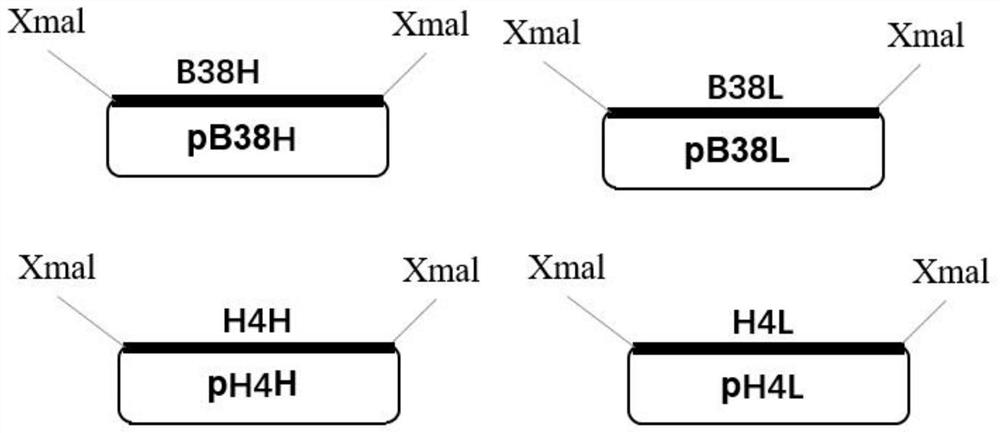Application of plants as hosts in expression of novel coronavirus pneumonia neutralizing antibody B38 antibody and/or H4 antibody
A coronavirus, B38 technology, applied in viruses/phages, botanical equipment and methods, applications, etc., can solve the problems of low production capacity of animal cells, low safety, complicated operation, etc., to improve product safety and convenient production. , purification and simple effect
- Summary
- Abstract
- Description
- Claims
- Application Information
AI Technical Summary
Problems solved by technology
Method used
Image
Examples
Embodiment 1
[0076] The construction of embodiment 1 plant transient expression vector
[0077] In order to provide high-efficiency expression of foreign aid proteins in plants, the human B38 heavy chain, light chain; H4 heavy chain, light chain, and protein sequence reverse translation software optimize their codons to plant-preferred codons for gene synthesis. Xmal sites were added to the optimized B38 light and heavy chain sequence, and the 5' and 3' ends of the H4 light and heavy chain sequence, and cloned into the pUC57 vector after gene synthesis to generate pB38H, pB38L, pH4H and pH4L cloning vectors ( Figure 1A , B). The gene fragments were separated from the cloning vectors by Xmal, and cloned into the binary plant vector, pCam35S, by homologous recombination to produce plant expression vectors p35S-B38H, p35S-B38L, p35S-H4H and p35S-H4L, respectively. The four plant expression vectors were respectively transformed into Agrobacterium tumefaciens GV3101 by electroporation with Mul...
Embodiment 2
[0079] Example 2 Agrobacterium-mediated vacuum infiltration
[0080] Mix the prepared Agrobacterium containing p35S-B38H and p35S-B38L in equal amounts until the O.D.600 is 0.5; similarly mix the Agrobacterium containing p35S-H4H and p35S-H4L in equal amounts until the O.D.600 is 0.5. The culture suspension was placed in a 2L beaker and placed in a desiccator. The lettuce kept in this laboratory was turned upside down (core up) and gently swirled in the bacterial suspension, and the desiccator was sealed. The vacuum pump (Welch Vacuum, Niles, IL, USA) was turned on to evacuate and the permeate was seen in the leaf tissue. Hold the pressure state for 30-60 seconds. The system is quickly opened to release the pressure and allow permeate to seep into the spaces within the tissue. This process was repeated 2 to 3 times until the penetration of the permeate into the lettuce tissue was clearly visible. The lettuce tissue was then gently removed from the permeate and rinsed three...
Embodiment 3
[0081] Example 3 Protein Extraction and Separation
[0082] Lettuce samples vacuum-infiltrated with Agrobacterium were stirred with a stirrer and homogenized in a mixer at high speed for 1-2 minutes with an extraction buffer (100mM KPi, pH7.8; 5mM EDTA; 10mM β-mercaptoethanol) with a volume ratio of 1:1 . The homogenate was adjusted to pH 8.0, filtered through gauze, and the filtrate was centrifuged at 10,000 g for 15 minutes at 4°C to remove cell debris. The supernatant was collected, mixed with ammonium sulfate (50%), and incubated with shaking on ice for 60 minutes. Centrifuge again (10,000g) for 15 minutes at 4°C. The obtained supernatant was subjected to a second round of ammonium sulfate (70%) precipitation, suspended by shaking on ice for 60 minutes, and centrifuged again at 10,000 g at 4°C for 15 minutes. Then, the supernatant was discarded, and the protein precipitated from the treated samples was dissolved in 5 mL of buffer (20 mM KPi, pH 7.8; 2 mM EDTA; 10 mM β-m...
PUM
 Login to View More
Login to View More Abstract
Description
Claims
Application Information
 Login to View More
Login to View More - R&D
- Intellectual Property
- Life Sciences
- Materials
- Tech Scout
- Unparalleled Data Quality
- Higher Quality Content
- 60% Fewer Hallucinations
Browse by: Latest US Patents, China's latest patents, Technical Efficacy Thesaurus, Application Domain, Technology Topic, Popular Technical Reports.
© 2025 PatSnap. All rights reserved.Legal|Privacy policy|Modern Slavery Act Transparency Statement|Sitemap|About US| Contact US: help@patsnap.com



